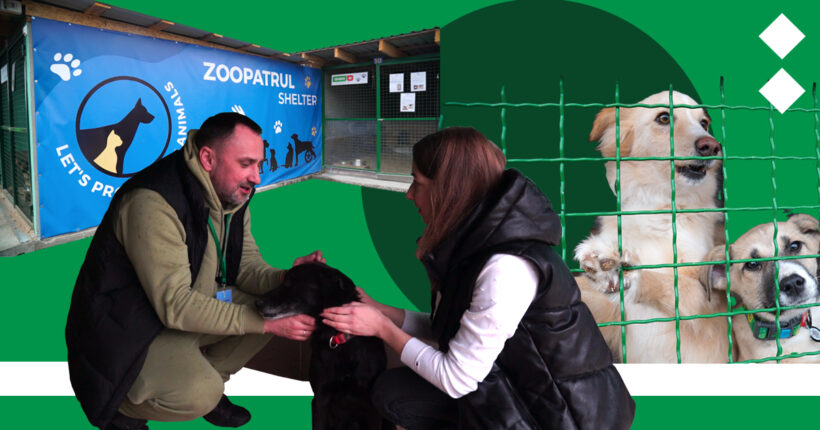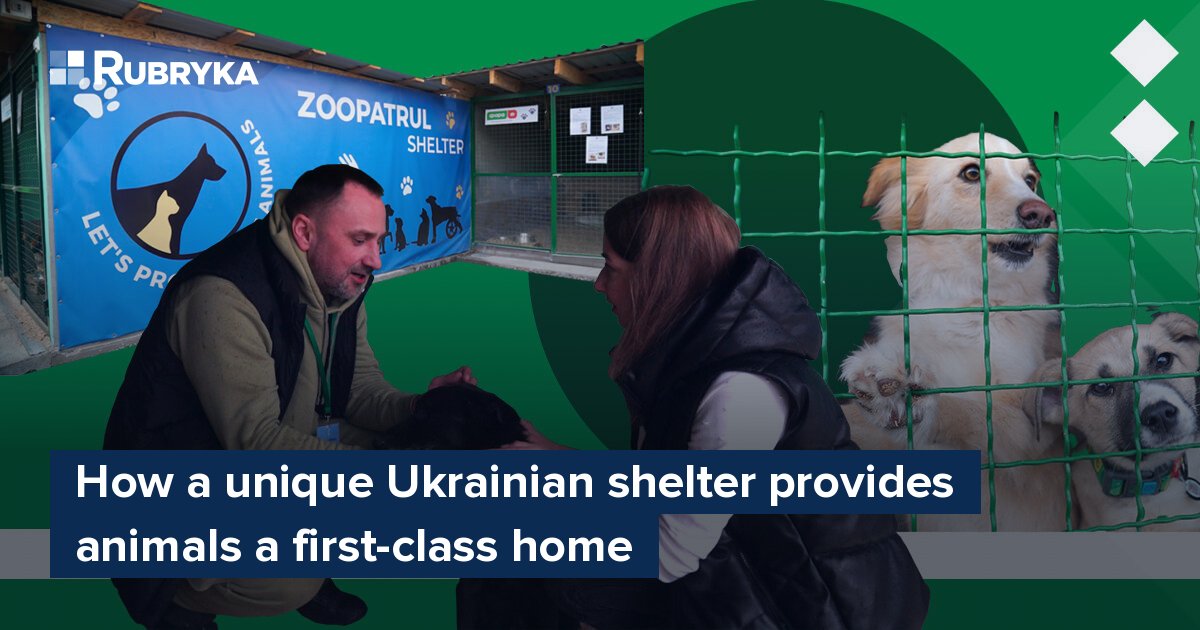
What is the problem?
At the beginning of the full-scale war, when people rushed to evacuat from the capital in a panic, some did not even stop to think about their pets. Some even cruelly left them behind in empty, locked apartments.
The war affected not only pets, but stray animals in the combat zone. Living on the street, they are suscpetible to injuries that can leave them injured or disfigured, if not killed by explosions and shrapnel wounds. Animals continue to need care today in combat hot spots, and unfortunately, even in peaceful cities, where cats and dogs can be hit by cars or abused by people.
However, there are many people who are not indifferent to the fate of their furry friends. Among them are the team of Zoopatrol UA, which aims to develop a model for animal shelters in Ukraine and abroad. Rubryka tells about the unique feature of the shelter for cats and dogs in Irpin, the Kyiv region.

What is the solution?
How it all began: a film crew rescued locked up animals
Dmytro Revniuk is a Ukrainian film producer and an animal lover, working to raise awareness about caring for them. Once, he even used to publish the magazine World of Veterinary Medicine, and another one, Zoodrug, is still being published.
With the outbreak of war, Revniuk, like most Ukrainians, felt the need to be helpful, so he began delivering food donations to the military. Then fate threw a new task his way: an acquaintance asked to save her dog, who was left in a locked apartment. Everything worked out, and Revniuk wrote a post on his social media channels offering to do the same for others. Over the next three days, 723 people wrote to him asking for help.

Revniuk took to a Telegram channel related to film production and invited his colleagues to join. The group created 23 patrols from movie lovers, acquaintances, and friends. Location managers, cinematographers, directors, and screenwriters worked together to free animals trapped in locked apartments. They used Google Sheets to coordinate applications, with details about the animal's situation, as specific as whether the toilet lid in the apartment was left open so that the animal had access to water.
In the first months of the war, journalists filmed volunteers breaking door locks and feeding abandoned animals. Later, volunteers from Revniuk's team invented another way: providing food and drink through a tube that passed through the apartments' peepholes.
Revniuk's memories from the first months of the war are touching:
"A 75-year-old gentleman found out that there were three locked animals in his building. We left food for him, and he knelt down and fed them one by one," recalls the volunteer.
There was another case when the volunteers heard a sounds that seemed to be an adult man kicking the door. It turned out to be a cat that was so deperate that it rushed to the door every time it heard footsteps, after being left alone for several weeks. When cats are saved from such dire circumstances, they purr so happily you can feel their gratitude through the door, Revniuk told Rubryka.
This is how Zoopatrol UA, the organization managed by Revniuk, was born and began to work. Now the charitable organization rescues, treats, and finds homes for animals.
From animal rescue to own veterinary clinics
When the Kyiv region towns of Bucha and Irpin were liberated from Russian occupation at the beginning of April 2022, Revniuk's team was already so well known that local authorities enrolled the volunteers in a humanitarian convoy. The organization took in every wounded animal — dogs without paws, animals with shrapnel and bullet injuries and put them in every veterinary clinic they could, having spent $6,500 on treatment only during the first week.
Volunteers already had an account for donations, and Ukrainians gave generously to their efforts to help the rescued animals. Still, the team understood it is difficult to be a sustainable organization relying on donations.

Photo: Zoopatrol UA
"Many veterinary clinics are commercial projects created to make money. Some of our animals were treated by veterinarians all the time, and it was a continuous and expensive process. Our goal is different — to cure the animal as soon as possible," says Revniuk.
"Once, we received a dog that needed spinal surgery, which cost about $2,700 at the vet clinic. I looked at how much a top veterinary surgeon earns in Kyiv — the average salary is about $1,100. Then we realized that having our own doctor who can perform such and even more expensive, [and] daily operations is more affordable."
Zoopatrol UA already has an infectious disease clinic and a resuscitation clinic. The first is the largest in Kyiv, having 74 infection boxes with oxygen supply. The second clinic is also equipped with the latest technology equipment. There was only one veterinarian at the beginning, but now 22 people are involved in the clinics. Without this element, the Zoopatrol system would not be able to function because the organization has a somewhat different concept from other shelters.

Photo: Zoopatrol UA. The organization has a three-step system of helping the animals.
Every day, Zoopatrol UA rescues up to five animals. If you see an injured animal, you can call the organization, and a patrol in a specially equipped car will come to the spot, take the animal and provide the necessary assistance. After treatment, the animals are sent to a shelter, and only then the adoption department finds them a new family.
How does it work?
European-style shelter. What does it mean?
The shelter was not established all at once. Volunteers initially kept the animals at home, but it was expensive — costing around $325 per month. After people donated $52 thousand to the organization, the team decided to build a shelter.
Currently, the PETA Foundation supports the shelter on a regular basis. Zoopatrol's board of directors includes a group of American doctors and animal volunteers who audit the accounts and help promote the shelter abroad.
At the entrance of Zoopatrol's territory, two rusty and dilapidated cages – with a hole in the roof from an explosion – contrast with beautifully painted new enclosures standing on the bare ground.

Photo: Zoopatrol UA. The new enclosures contrast with the one destroyed by the explosion.
Before the war, there was also a shelter here, which got caught up in the hostilities. Many animals died, and some ran away to the surrounding areas. The only remaining resident is the dog Boroda, whom the shelter's team calls "Director". His enclosure is always open, and only he has the exclusive right to rest in the office with people. The team doesn't know where the other animals from the previous shelter are now, their absence evidenced only by the empty old cages. The team left the destroyed enclosures as a counterexample to their work to revive the animal sanctuary.

Photo: Zoopatrol UA. The team-member is rounding the animals.
"We visited different cities in Europe, saw how shelters are built there, and made ours even better," says Revniuk.
The new enclosures are lined with tiles and sawdust, which are regularly changed. Each has a wooden booth with a warm floor underneath. The heating was not turned off even during power outages — the territory is equipped with a generator, so the dogs are always warm. Another important nuance was considered during the construction: for the enclosures to remain clean and to make washing easier, a special drainage system was made. The cages are quickly washed with a hose while the dogs are being taken out for a walk. The animals then return to well-kept, tidy enclosure with no unpleasant smells.
Does it really work?
A successful case study of the adoption department: how advertising campaigns help animals find a new home
Already seven months into its existence, Zoopatrol UA has managed to accommodate more than a thousand animals, while another 200 live in the shelter.
Revniuk has an extensive network of acquaintances in the film community that were vital at the beginning of the organization's work, filming commercials that helped to tell about the case to a wide range of influencers and journalists.

Source: Zoopatrol UA
The Zoopatrol UA team makes videos, and many animals have already gotten widespread attention. There were days when employees gave a tour to Danish journalists, others for French ones, and then influencers coming from abroad. As a result, after one of these visits, where the team introduced a cat from Irpin, 30 of the shelter's cats were rehomed in Paris.
Animals from the Zoopatrol find their home not only in Ukraine. They travel all over the world, and, according to Revniuk, most often, they are adopted by Ukrainians currently in Europe. People usually pay the travel expenses, but if they cannot, the Zoopatrol team finds volunteers who arrange for the transport for free.
A mandatory condition for the adoption of a four-legged friend is a contract. The organization also requires a video report from the new owners within a month.
The shelter continues to develop, with plans to build a house especially for cats. Some enclosures are ready but remain empty, waiting for new residents who will be there temporarily until they find a home – which, as it turns out, could be in any corner of the planet.







